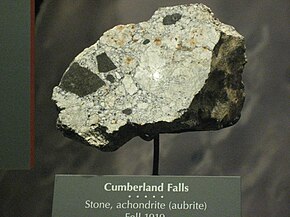

| Achondrite | |
|---|---|
| — Type — | |

Cumberland Falls, achondrite (aubrite)
| |
| Compositional type | Stony |
 Aeucrite achondrite from the Millbillillie meteorite shower. | |
Anachondrite[1] is a stony meteorite that does not contain chondrules.[2][3] It consists of material similar to terrestrial basaltsorplutonic rocks and has been differentiated and reprocessed to a lesser or greater degree due to melting and recrystallization on or within meteorite parent bodies.[4][5] As a result, achondrites have distinct textures and mineralogies indicative of igneous processes.[6]
Achondrites account for about 8% of meteorites overall, and the majority (about two-thirds) of them are HED meteorites, possibly originating from the crust of asteroid 4 Vesta. Other types include Martian, Lunar, and several types thought to originate from as-yet unidentified asteroids. These groups have been determined on the basis of e.g. the Fe/Mn chemical ratio and the 17O/18Ooxygen isotope ratios, thought to be characteristic "fingerprints" for each parent body.[7]
Achondrites are classified into the following groups:[8]
Primitive achondrites, also called PAC group, are so-called because their chemical composition is primitive in the sense that it is similar to the composition of chondrites, but their texture is igneous, indicative of melting processes. To this group belong:[8]
Asteroidal achondrites, also called evolved achondrites, are so-called because they have been differentiated on a parent body. This means that their mineralogical and chemical composition was changed by melting and crystallization processes. They are divided into several groups:[8]
Lunar meteorites are meteorites that originated from the Moon.
Martian meteorites[10] are meteorites that originated from Mars. They are divided into three main groups, with two exceptions (see last two entries):
|
| |||||||||||||||||||||||
|---|---|---|---|---|---|---|---|---|---|---|---|---|---|---|---|---|---|---|---|---|---|---|---|
| Meteorite... |
| ||||||||||||||||||||||
| Classification |
| ||||||||||||||||||||||
| Mineralogy and petrology |
| ||||||||||||||||||||||
| Lists |
| ||||||||||||||||||||||
| |||||||||||||||||||||||
| Authority control databases: National |
|
|---|